AMD vs Nvidia: Whose Driver Updates Improve Performance More?
Hitman (2016, DX12)
After our look at Rise of the Tomb Raider’s Foundation engine and Hitman’s Glacier engine, we’re up to six distinct renderers.
As with RotTR, we added Hitman to our benchmark suite as a DirectX 11-based test. But after two years of patches (and the addition of features like HDR), the game is plenty stable in DirectX 12 mode.
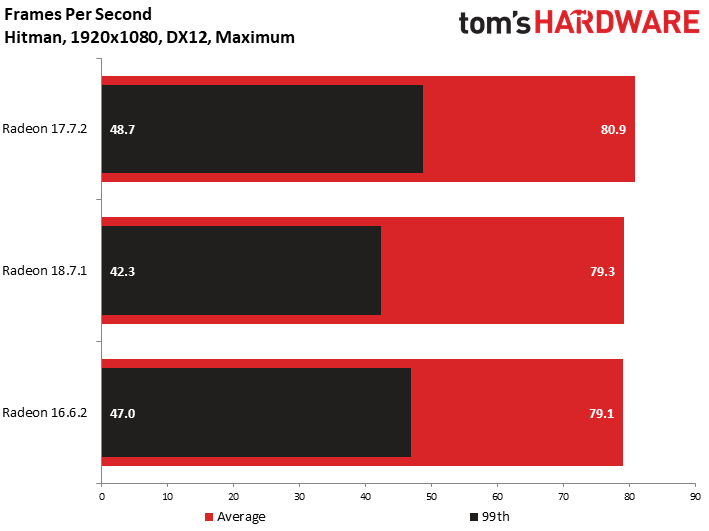
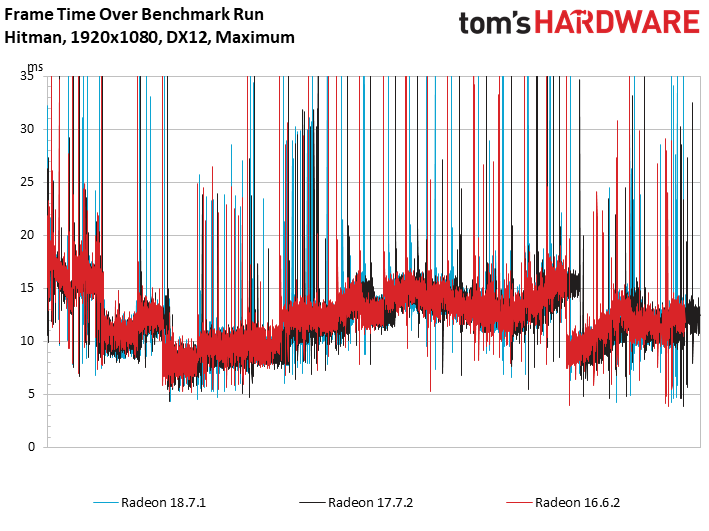
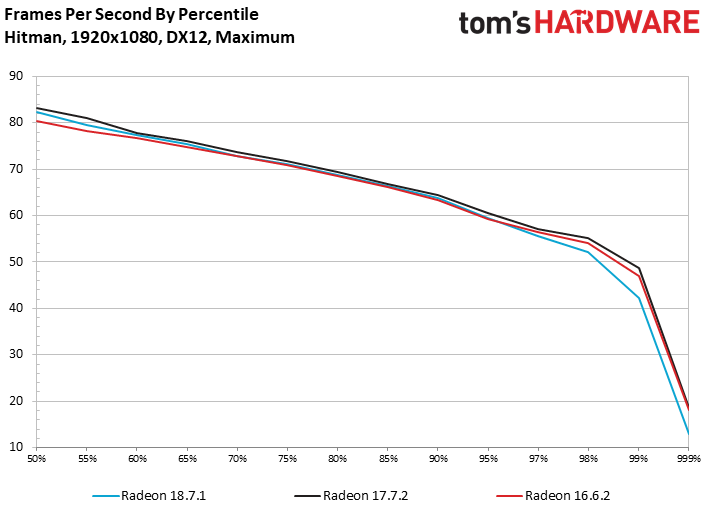
Hitman was part of AMD’s Gaming Evolved initiative. The company worked with IO Interactive to build in support for Eyefinity multi-display configurations, widescreen resolutions, super-sampling anti-aliasing, and asynchronous compute. Perhaps that’s why the Radeon RX 480 started strong in 2016 and gained very little over the years—one quarter of a percentage point, by our calculations.
All three of the driver builds we tested track very closely in an accounting of frames per second by percentile.
A look at frame time over the benchmark run shows why the slowest 1% of frames are so slow: frame time spikes throughout our 100-second sequence imply severe stuttering issues. However, experience and qualitative observation tell us that many of those peaks are attributable to scene changes in Hitman’s integrated benchmark.
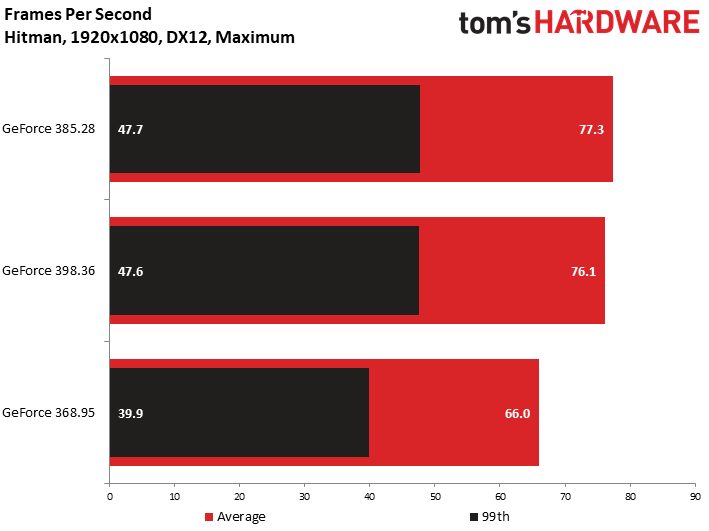
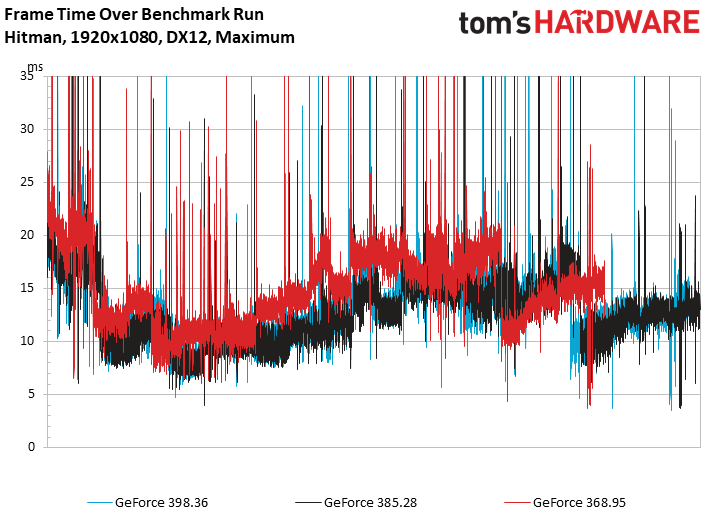
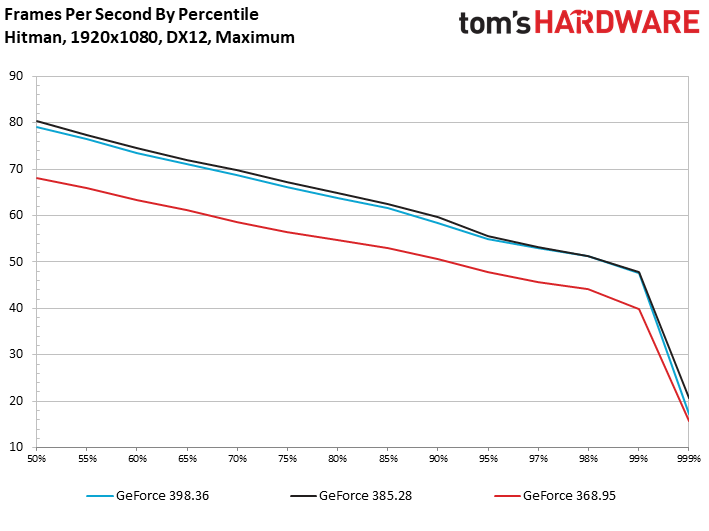
The GeForce GTX 1060 6GB’s frame time results are similar to AMD’s, corroborating our hypothesis that those ugly spikes are inherent to the test sequence and not a two-year-old bug suffered by both GPU vendors.
Nvidia overcomes initially poor performance, speeding up more than 15% across two years of driver updates. That’s not enough to usurp the Radeon’s advantage, though. AMD maintains a 4% lead at 1920x1080 using Hitman’s highest detail settings under DirectX 12.
Get Tom's Hardware's best news and in-depth reviews, straight to your inbox.
MORE: Best Graphics Cards
MORE: Desktop GPU Performance Hierarchy Table
MORE: All Graphics Content
Current page: Hitman (2016, DX12)
Prev Page Rise of the Tomb Raider (2016, DX12) Next Page Tom Clancy’s The Division (2016, DX12)-
Tmanishere If you compare the cost of Freesync monitor vs G-sync monitor, AMD usually edges over Nvidia in terms of performance vs cost.Reply -
bloodroses A comparison of cards a couple generations old would be a good article as well since these cards are still considered current. It's a pretty common myth that AMD has better support long term whereas Nvidia either drops decent (or even cripples) support on any hardware that isn't current gen. It would be interesting to see the validity in it.Reply -
jimmysmitty Reply21214234 said:i still go for AMD to keep a competitor alive
Only if the price is right. I can't even understand anyone who bought an AMD card when the crypto-currencies were inflating the price to insane levels.
21214277 said:If you compare the cost of Freesync monitor vs G-sync monitor, AMD usually edges over Nvidia in terms of performance vs cost.
True but then the monitor isn't part of the GPU nor is affected by drivers. If thats an important metric for someone then yes it helps. However it doesn't help AMD perform better.
21214328 said:A comparison of cards a couple generations old would be a good article as well since these cards are still considered current. It's a pretty common myth that AMD has better support long term whereas Nvidia either drops decent (or even cripples) support on any hardware that isn't current gen. It would be interesting to see the validity in it.
I don't think there is any validity to it. Its probably came about when new GPUs get released newer drivers sometimes rarely have updates for older hardware. This isn't exclusive to nVidia. I ran ATI then AMD GPUs for 10 years and plenty of times new drivers would come out and performance gains would only apply to new GPUs and not my 1 or 2 gen old GPU.
I do think nVidia has more driver releases than AMD. However driver updates and performance gains all depend. It depends on which games each company focuses on. That might be why some gains are better for each in some games. -
Peter Martin oh yeah, I only buy on good deals.. lol, I don't understand anyone always having to have the latest either. I can wait a few yrs to play video games affordably.Reply -
Johnny Baker I will always favor AMD over Nividia any day. I am not impressed at all by what people claim to be facts. All I can tell you: I'm and AMD freak, always will be, and proud of it.Reply -
derekullo This article reminded me of a quote in another article from a decade ago.Reply
"AMD and Nvidia release numerous driver builds every year. If each of these drivers were to increase 3D speed by 10 percent, the graphics cards would double their performance in a few months. "
https://www.tomshardware.com/reviews/GeForce-Catalyst-overclocking,2037.html
They backtrack a little bit, but I still laugh when I see Nvidia/AMD report an increase of 10% on every little driver update.
For a trip down memory lane and a display of how the chart making skills at Tom's has improved let me reintroduce;
https://www.tomshardware.com/reviews/GeForce-Catalyst-overclocking,2037-14.html -
Matt_550 Should've opted just for the 580X vs 1060 comp since the 480X had to be nurfed because of the failure of its power delivery system that was upgraded for the 580X.Reply -
jimmysmitty Reply21214551 said:This article reminded me of a quote in another article from a decade ago.
"AMD and Nvidia release numerous driver builds every year. If each of these drivers were to increase 3D speed by 10 percent, the graphics cards would double their performance in a few months. "
https://www.tomshardware.com/reviews/GeForce-Catalyst-overclocking,2037.html
They backtrack a little bit, but I still laugh when I see Nvidia/AMD report an increase of 10% on every little driver update.
For a trip down memory lane and a display of how the chart making skills at Tom's has improved let me reintroduce;
https://www.tomshardware.com/reviews/GeForce-Catalyst-overclocking,2037-14.html
Those 10% though ar enot for the same game every time. If you read driver notes they typically state what performance gains you might see on what game and what hardware.
There is very rarely a just generic across the board performance improvement for all games. Now if the companies could focus on say just the API and improve the performance on DX12 then that could apply to DX12 titles but it still does not work that way unfortunately.

